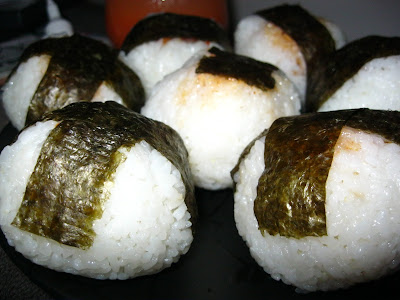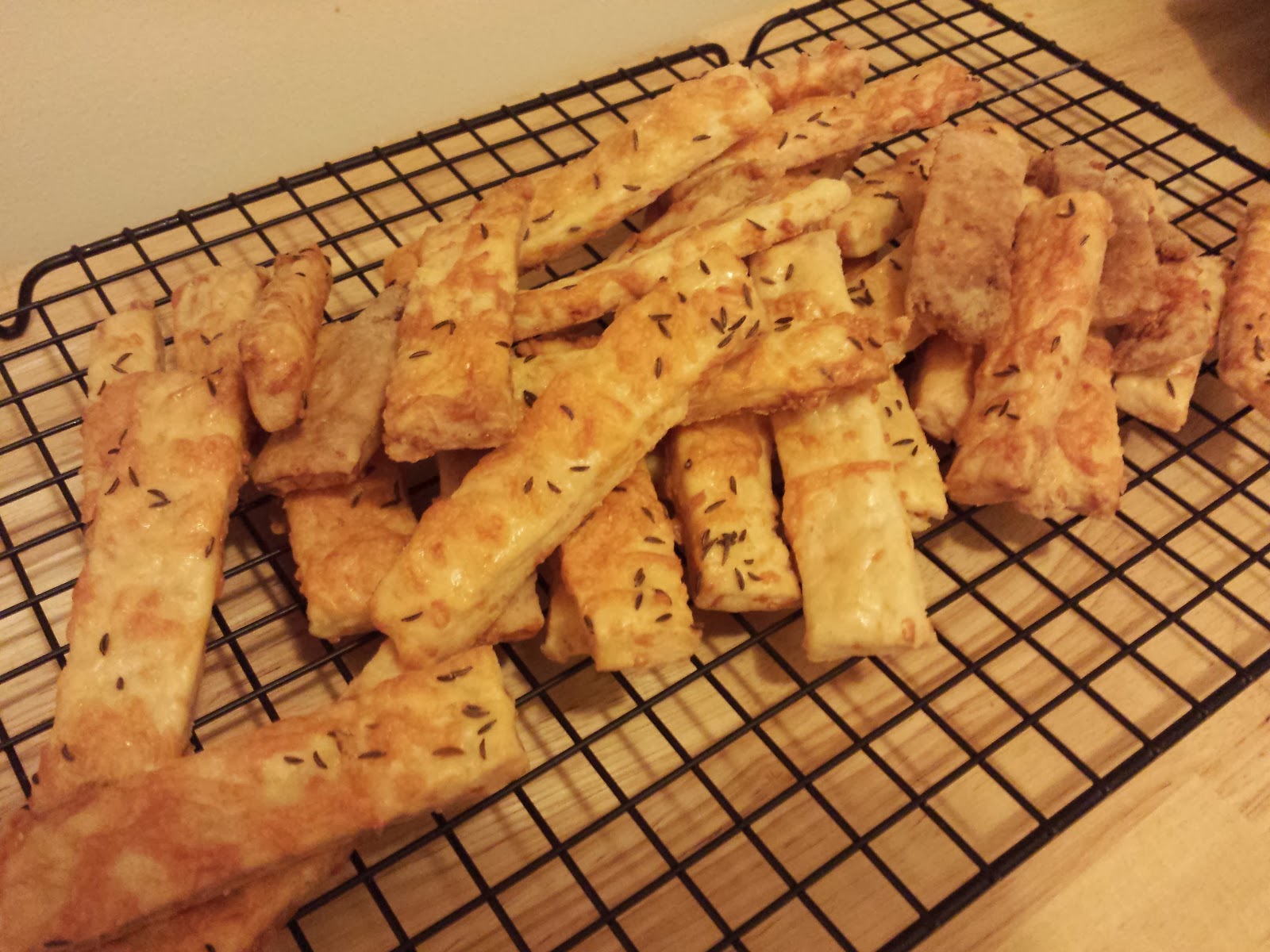Onigiri
Onigiri are Japanese rice balls, which are traditionally filled with salty, preserved foods but have been adapted to all kinds of tastes. For a good run-down of the history and varieties of onigiri, check out Just Bento. My sister and I made these a couple years ago, inspired by a re-watching of our childhood favorite, Ranma 1/2 (hands down the funniest and best-dubbed anime I have ever seen), and they were fabulous. Much better than our similarly-inspired attempt at okonomiyaki. Please note that, at the time, neither of us had ever eaten (or seen in real life) onigiri or okonomiyaki.
I got inspired to try another round of rice balls when I ran across some nice-looking fake crab meat in the grocery store today. Is that a weird thing to be inspired by? It was pretty exciting, especially because it was just starting to storm and I was in a really good mood for the first time in this whole sweaty week. And for whatever reason, I really, really love fake crab meat (in a totally different way than I love the real stuff).
I made two kinds of onigiri, one filled with a pretty standard Asian-style crab salad (much like this one I made ages ago) and one with a carrot kinpira. Neither one is authentic, and I'm not sure the kinpira can actually rightly be called kinpira. But the first time I made it I used a real recipe and it tasted pretty much the same, so whatever. The measurements in the recipes below are VERY rough, as I was just sort of throwing things together, so change the proportions to your own taste.
The first step in making onigiri is to put some rice on to cook. It has to be sushi-type rice (Calrose or Japonica), and you have to rinse it well in cold water before you cook it. I highly recommend spending a few bucks on a small, single-button rice cooker (I have this one
Once the button on the rice cooker pops up, leave the lid on for ten minutes to finish cooking the rice. After that point, take the lid off, fluff the rice, and let it cool for fifteen minutes or so before you start putting together your onigiri. You want it to be quite warm, but not so hot you burn your hands. Ideally, anyway. Being me, I got impatient and burned myself a little. It was worth it, though.
While your rice is cooking, start the fillings. You want everything to be chopped up as small as possible, because it makes stuffing the rice balls much simpler. You can put virtually anything that isn't too wet into onigiri, but these are the two I've used both times.
Crab Salad
4-6 ounces imitation crab meat, roughly chopped or torn into small bits
2 tablespoons mayonnaise
1 teaspoon chili-infused sesame oil
1 1/2 teaspoons rice vinegar
1 teaspoon hot paprika
2 teaspoons sweet paprika
Whisk the mayo, oil, vinegar, and paprika together in the bottom of a small bowl. Dump in the shredded crab meat and stir through. Add more crab if there's too much sauce. Refrigerate for at least half an hour (it's really better if it sits overnight but I rarely have that sort of forethought).
Carrot Kinpira
3/4 cup julienned carrots, roughly chopped into shorter pieces
1/3 small red onion, diced small
1 large clove garlic, minced
1 teaspoon/splash sesame or vegetable oil
1 1/2 teaspoons/splashes mirin
1 1/2 teaspoons/splashes soy sauce
dry or fresh rosemary to taste
1/2 teaspoon ground ginger
1 teaspoon crushed red pepper
Heat the oil over medium-high heat and put in the onions. When they start to soften, add the carrots, rosemary, and other wet ingredients. After a few minutes add the garlic, and stir-fry until everything is softened. Add the ginger and crushed pepper, and saute until the liquid is all absorbed and the carrots start sticking to the bottom of the pan. Transfer to a small dish.
Set up your fillings, your pot of rice, some strips of roasted nori (optional), a roll of cling wrap, a couple of small spoons, and a medium-sized teacup on your work surface. Tear off about six to eight inches of the cling wrap, and drape over the top of the cup. Plop a scoop of rice (about half a cup, maybe) into the wrap. (Note: I got the idea to do this with cling wrap from the awesome proprietress over at Just Bento and Just Hungry, but she uses the cup to shape her onigiri, which didn't really work for me. Play around until you figure out what works for you.)
Gather up the edges of the wrap and use it to shape the rice into a round ball. Twist the top and squeeze the rice to pack it firmly, then open the film and use your fingers (you can drape an edge of the film over the rice to protect your hands from stickiness) to create a cup in the middle of the rice ball. I prefer a lot of filling, so I pretend I'm back in grade school art class making a pinch pot.
Scoop a tablespoon or so of filling into the hole, using the spoon to pack it together. Pull the edges of the wrap up again, using your other hand to squeeze the edges of the rice-cup back together, and pushing the filling inside the opening (this is when it's most useful to use an edge of the cling wrap). It's okay if a little still shows--that's what the nori is for. Stick a strip or a shape of it over the top of the rice ball, covering the hole where the filling shows. If you like your nori very crispy you should do this just prior to eating it, but I find that it is more pleasant (and better at holding things together) if it gets a little damp from the warm rice. I've found that it's easiest to let each ball sit in the cling wrap for a minute or two (I cut two pieces and just alternated fillings) to make sure the shape sets before you unwrap it and stick on the nori.
Obviously my onigiri are not nearly as pretty as most of the ones you find on Japanese food blogs (or in shops, for that matter), but they're pretty delicious. My sister is much better at making even-sized, aesthetically pleasing ones, but unfortunately she couldn't get the keys to the teleporter tonight. Also she doesn't like fake crab meat. I think next time I will mix some black sesame seeds into the rice, just to make them more interesting-looking. I also pulled out a packet of panko but didn't end up using it for anything. I've heard that in Japan people sometimes dye the rice fun colors, which seems appealing. Maybe I'll make crab-stuffed "easter eggs" next year.
I hope that wasn't too confusing. These things are great for traveling snacks (if you use fillers that don't need to be refrigerated), are a traditional component of bento box lunches (ridiculously pretty food + organization? I love bentos.) and can be stored overnight wrapped in cling film in the fridge. They're pretty filling, being mostly rice, but you can use them as an appetizer or side-dish for a more elaborate meal. Un-filled rice balls are called onigiri too, and look nice when served with a curry or stir-fry dish.
















Comments
Post a Comment